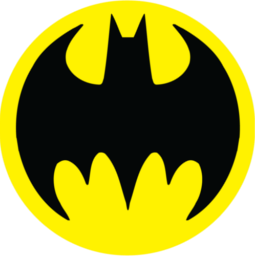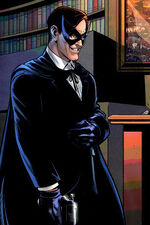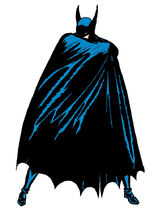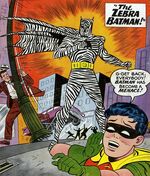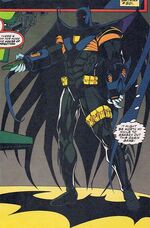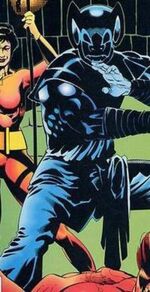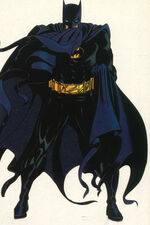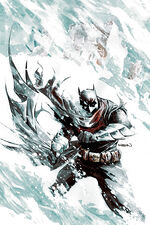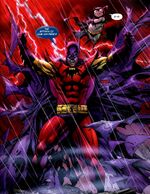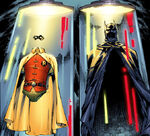One of Batman's most recognizable items among his prized possessions in fighting crimes in Gotham City is his unique costume. It is popularly known simply as the Batsuit.
The Batsuit has an electrical system that can shock assailants as a last resort. The Batsuit is made of triple-weave kevlar centered around the most obvious target, the chest-mounted Batsymbol. Though the suit has been drawn many different ways by different artists, and the stories themselves have described Batman as modifying the details of his costume from time to time, it is most often depicted as consisting of a scalloped cape, a bat-like cowl, a pair of gloves, boots, a yellow utility belt, and a tight-fitting body suit with the image of a bat emblazoned on the chest.
Batman wears this costume both to conceal his identity, and to frighten criminals. Most versions of the Batsuit incorporate some form of body armor, and often night-vision, gas filters, and other aids to combat effectiveness or protection. All versions of the outfit incorporate a utility belt containing a variety of crimefighting equipment.
History
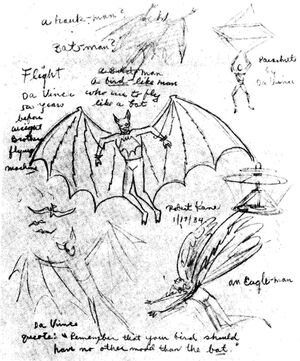
While brooding in his study over how to be a more effective crime fighter, Bruce Wayne saw a bat come through his window (in the earliest Detective Comics portrayal simply flying in an open window, in Post-Crisis continuity such as Batman: Year One, dramatically crashing through the glass) and perch on the bust of his father. Realizing that "criminals are a superstitious, cowardly lot," Bruce adopts the persona of a bat in order to conceal his identity and strike fear into his adversaries. Subsequent origin tales have had Bruce terrified by bats as a child, and observing a bat costume worn by his father at a costume ball, but the primary impetus of his decision to adopt the bat persona has always been the incident of the bat coming in the window of his study. It is as a result of this incident that the batsuit was developed.
As Bruce's career as Batman continued, he evolved and updated the suit to keep ahead of technology in the streets of Gotham, using the resources of Wayne Enterprises to do so. Eventually the suit itself became a kind of totem and symbol for himself and others, an example of the realm of darkness defending the realm of light.
Description
- Basic suit
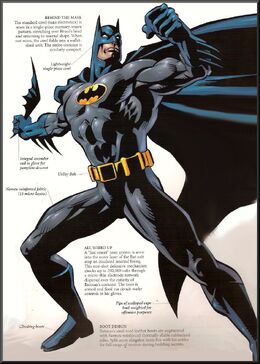
The basic foundation of the Batsuit is a tight-fitting bodysuit, similar to many superheroes. In early depictions, it was similar to the garb of early 20th century circus performers. Batman #1 revealed that there is a ballistic vest sewn into the costume. In modern depictions, the briefs are integrated into the main costume, so that section of the costume constitutes only a seam and color change from the rest of the suit. The bodysuit has varied in color and style as depicted by different artists.
The Post-Crisis version of the bodysuit is not constructed from simple fabric, but from Kevlar thread and carbon nanotube fibers. This imparts it with a unique sheen and makes it heavily resistant to tearing. In addition, the suit also is constructed with a full body electric shock delivery system, which is also layered into the suit's fabric. The basic version of the Batsuit is insulated against electricity and is mildly fire resistant. Batman utilizes many different body armor designs, some of which are constructed into his Batsuits, and others which are separate. In its most basic version, the suit is bulletproof around the upper torso and back and can withstand a point blank range blast from a 12-gauge shotgun. Other versions are entirely bullet proof to small arms fire, and have advanced flexible armor plating made from Carbon composites and lightweight metal polymers.
- Cape
As different artists have taken over the responsibility of drawing the character, the details of the suit have changed considerably. The original incarnation of the cape was a wing-like structure inspired by drawings by Leonardo da Vinci. This eventually evolved into a more cape-like design of varying length. Some artists draw the cape with protrusions on the shoulders, likely representing the "thumb" part of a bat's wing, though this is not a consistent addition. The cape is occasionally depicted as bulletproof.The cape varies according to the current writer, sometimes being depicted as bulletproof and fire resistant, and other times being nothing more than simple fabric that tears easily and sustains constant damage and is continuously replaced.
- Gloves
In the earliest Batman stories of Detective Comics, the costume featured a few curiosities before it evolved in to its more or less standard style. The first gloves were purple in color, ordinary looking, and lacked any sort of scalloped fins or other stylings, and only came to the wrists. The second Batman adventure depicted the character wearing no gloves at all. A few issues later the gloves became longer, and by 1940 the familiar fins were added (in early stories, these pieces originally resembled miniature, scalloped bat wings, but eventually became three simple triangular fins). In some later incarnations, the scallops are attached to a separated bracer worn below the glove around the wrist. Additionally, the gloves have been specially treated to be both shock-proof as well as radiation-resistant.The glove designs that incorporate fingertip blades also have joint armor-reinforcement in the glove, from the wrists and knuckles to the fingers. He also has electrical shockers in the fingertips of his gloves, which are used to control the structure of his cape. Additionally, Batman hides a few pieces of his arsenal in his gloves, such as a lock pick.
- Armor
The Batsuit has been repeatedly updated in order to reflect advances in technology. Originally the costume contained no protective armor, since the creative talent felt that it made Batman seem too powerful to see him shrug off bullet hits. However, the real world advent of various forms of personal protective materials like Kevlar and the realization that being shot while wearing such protection still should be avoided, has led to the costume being re-imagined with varying forms of bulletproof protection which employs the aforementioned use of the suit's chest symbol to lure shots at the armor's strongest point. Despite the armor, Batman almost always evades gunfire and is very rarely actually shot. After recovering from his spinal cord injury (the result of Bane's attack), Batman reinforced the armor with a material to dampen shocks and impact, along with a spinal brace, to protect himself from such abuse.
- Cowl
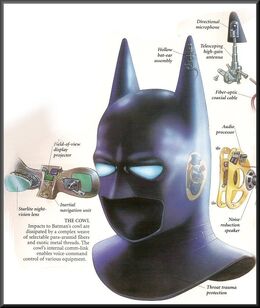
Batman's cowl
The cowl's basic design has remained unchanged; however, it has been frequently updated to advance Batman's crusade. The one aspect of the cowl that does undergo variations is the ears, although the length and pointiness of the ears is supposedly primarily due to the style of the artist drawing Batman, and tends not to be tied to the functionality of the cowl in any way. However artist Karl Kerchl has drawn Batman's costume vault showing that he has a wide selection of cowls with ears of different lengths (Adventures of Superman #643).
In addition to concealing his features and contributing to his imposing appearance, Batman's cowl has sometimes served other purposes. Occasionally, the cowl is depicted as having defense mechanisms such as electric shock or stun gas in order to prevent unauthorized removal.
The cowl contains shifting lenses that identifies suspect's identities, as well as their weak points (through medical records), while simultaneously avoiding the possibility of eye identification. The lenses have special visions, like infrared vision (heat sensors), night vision, and ultraviolet vision.
In addition, because some meta-human criminals have the power to see through solid objects, Batman lines the cowl with lead to protect his identity. One of the cowl's ears carries a high-gain antenna for an internal comm-link on the left side of the cowl, allowing Batman to stay in contact with his allies. The comm-link can also scan police radios and other communication frequencies. It also carries an inertial navigation unit to keep him in balance when facing foes such as the Scarecrow or Count Vertigo.
The cowl's Kevlar panels provide a level of protection for his head against firearms. The front of the skull and the sides of the temples also have small armor inserts to increase the effectiveness of skull strikes and protect from concussive blows. Repeated encounters with the Mad Hatter also forced Batman to shield his cowl against the villain's mind control.
- Boots
In Batman: Year One, it is depicted that Batman hid a few pieces of his arsenal in his leather boots, such as a blow gun with fast-acting anesthetic darts and an ultrasonic device built into his left heel. Batman's boots are highly unique. The basic design of the boots are modeled on Tactical boots, but they are made from lightweight rubbers and are much more flexible to allow for full extension when kicking. The boots feature a unique "slingshot" ankle reinforcement design that acts as both armor and as reinforcement for the ankle joint when kicking or landing from high distances. The bottom is a flexible split sole design and is textured for a variety of surfaces. The boots also have steel toes, making them much more effective when on the offensive. Although Batman is already an accomplished Olympic level swimmer, during the Batman: Hush storyline, it is revealed that he installed underwater propellers in the heels. In Batman Begins, a boot heel is revealed to contain a ultrasonic signaling device capable of calling live bats to it as a form of protection and cover for Batman during a getaway. This device was originally introduced in the Batman: Year One series.
- Utility belt
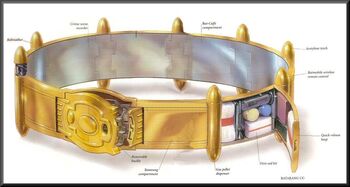
Batman's Utility Belt.
Batman's utility belt is his most characteristic prop next to the Batarang, much like Wonder Woman's Lasso of Truth, or Green Lantern's power ring. The exact contents of this belt are not known because Batman usually changes it to suit his needs. His uncanny ability to carry unusually appropriate tools is legendary. Batman's enemies are especially interested in the utility belt as they believe it will give them an advantage over him, but the belt's pockets are locked and only Batman knows how to open them. Occasionally, the utility belt is depicted as having defense mechanisms such as electric shock or stun gas in order to prevent tampering.
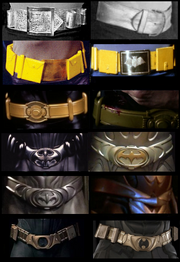
Different incarnations of the Utility Belt on film.
The array of devices Batman carries have become more complex over time. The simple coiled rope and batarang scaling equipment became a rocket powered (or compressed air powered) grapple gun. The suit has also carried on different occasions a re-breather device, flash and gas grenades, explosives and a detonator, lockpicks, a signaling device for the Batmobile, electronic surveillance equipment (including video camera and monitor), a forensic kit for gathering crime scene evidence, a medical kit, a cache of money and, in early incarnations, a pistol in a holster. On any occasion where Batman anticipates encountering Kryptonians, he has also carried (in a lead case) a Kryptonite Ring, given to him by Superman as a weapon of last resort.
Evolution and Variants
- See Also: Batsuit/Armor
In addition to the suit's continuous evolution, Batman keeps variant costumes for dealing with extraordinary situations; for example, he has been shown in a Scuba variant of his costume, a fireproof version for fighting his enemy Firefly, a thermal insulated version for fighting Mr. Freeze, as well as others. Many versions of the hero show him swapping his cloth costume for a suit of powered armor.
Thomas Wayne "Batsuit"
Long before Bruce Wayne became Batman, Thomas Wayne wore a "batsuit" to a costume ball. The costume consisted of a domino mask and a cape cut in a manner suggesting wings. According to some stories, Thomas foiled a crime while wearing the suit. Batman kept it in a glass case similar to the suits of his fallen partners. Dr. Hurt has since taken it and worn it as his own, as he claims to be Bruce's father. It was assumed lost when Dr. Hurt plunged into the Gotham Bay, but he has since resurfaced wearing it.
Bob Kane "Year One" Batsuit
Designed by Bob Kane in 1939, the original rendition of the suit was little more than gray tights covered with black trunks, short gloves, boots and a scalloped cloak that was affixed to his arms. He wore a bulletproof vest underneath the suit.
Zebra Batsuit
While battling the first Zebra-Man, Bruce Wayne was accidentally irradiated by the same energy that had irradiated Jake Baker. Without an inhibitor belt, Bruce's diamagnetism powers were out of control, causing Robin to go on without him. Batman soon took advantage of the diamagnetism, however, and used it to attract Zebra-Man to him and attract both of them to Gotham City Police Department.
Neal Adams Batsuit
By 1995, the suit was eventually modified, the cloak becoming a scalloped-edged cape and the gloves becoming gauntlets with three “fins” with claws imbedded in the fingers for climbing. Famously drawn by the likes of Neal Adams and Jim Aparo, he eventually he created a unique fire-retardant and chemical-resistant triple-weave Kevlar thread for the suit. The material had carbon nanotube fibers that imparted it with a unique sheen and made it heavily resistant to tearing. This material would go into the creation of all following batsuits and other suits in the Bat Family.
The most notable traits of this evolution was the incorporation of the yellow ellipse around the bat emblem as well as the capsule utility belt.
Azrael Batsuit
- See Also: Batsuit (Jean-Paul Valley)
After Bruce Wayne was defeated and crippled by Bane, he nominated Jean-Paul Valley to take up the mantle of Batman while he recovered. While initially wearing Bruce Wayne’s uniform, Jean-Paul would eventually begin to succumb to his “programming”, becoming more and more corrupted by the crime he was fighting, and replaced the suit with his own tailor-made armour with razor disks, blades and hidden weapons, becoming a more aggressive and unstable Batman, known among comic-fans as the “Azbat” ("Azrael-Batman").
This suit debuted in Batman #500, designed by Joe Quesada and Aparo.
Mask of Tengu
A martial art garb designed around the totem of the bat. While retraining his body after having his back restored by a mutant with healing powers and then going through physical therapy Bruce Wayne was given the Mask of Tengu by Lady Shivaas a substitute Bat-Uniform during the final stages of his retraining, before this he wore a standard ninja outfit with a hood.
Troika Batsuit
Since his creation, Batman had worn trunks outside of his pants, a style shared by many superheroes introduced in the 1930s and 1940s. This was partly because initial superhero costumes of the time were inspired by circus outfits.
But in the mid-1990s, many thought that the trunks were a quaint design flaw that didn’t belong in modern-day superhero costumes. In the storyline “Troika”, Batman experimented with his look and made a new batsuit. The blue was replaced by black and coal gray colours. The bodysuit was now all one piece, with no visible division between boots and gloves, spikes were added to the boots in a style similar to the gloves and the shorts were completely gone.
While the boots and gloves would change back to being seperate from the body suit after the "Troika" storyline, the absence of the trunks would continue for a few years before returning.
2000 "No Man's Land" Batsuit
After suffering through two plague outbreaks and a horrible earthquake, what remained of Gotham City was eventually cut off from the rest of the United States and forced to fend for itself.
Batman had to rethink his tactics and with miniature crime-fighting equipment no longer being necessary or practical in a No Man's Land, he altered the belt to a larger version previously seen in Frank Miller's “Batman: Year One” comic series.
Following the No Man's Land event, Bruce opted to return to the colour scheme and logo design of the original batsuit, most notably shown with the removal of the yellow oval from the bat emblem.
Suit of Sorrows
- See Also: Suit of Sorrows
Created in 1190 during the Crusades, the Suit of Sorrows was bestowed upon Batman by Talia al Ghul as a gift, and although it made him significantly stronger and faster, he was forced to stop using it when he began to believe it was somehow corrupting him and making him more violent. However, Batman was unable to bring himself to destroy the artifact, and instead chose to store it on display in the Batcave.
Zur-En-Arrh Batsuit
This batsuit is the batsuit of a parallel universe Batman made up of a purple cape, gloves, mask and boots, a red shirt and red pair of pants, a yellow belt and yellow sleeves.
Bruce Wayne's "Last Batsuit"
Thought to be the cowl worn by Bruce Wayne when he was "killed" in a confrontation with Darkseid during the Final Crisis. Bruce Wayne's last batsuit actually refers to two suits; one worn by Bruce as he was thrown through time by Darkseids Omega Sanction and one worn by the corpse of a Bruce Wayne clone that Darkseid had the Earth's population believe was Bruce.
The cape and cowl of the suits are prominantly displayed as Bruce Wayne's spiritual presence in proceedings after the Final Crisis. With the cape and cowl of the clone being displayed alongside the other batsuits as a memorial that Richard Grayson would constantly return to and ultimately forge his own decision to become the new Batman, while the cape and cowl of Bruce misplaced in time would become a holy relic of the Miagani Tribe from the prehistoric era onwards, enshrined in the caverns that would eventually become the Batcave.
Dick Grayson's Batsuit
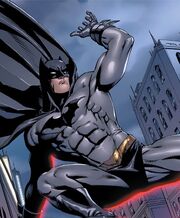
Following Bruce's seeming death at the hands of Darkseid, Dick Grayson reluctantly took up the mantle despite instructions Bruce left for him not to do so. Grayson made some modifications to the Batsuit to better suit his combat style. Having always hated capes, the first thing he disposed of when creating his Nightwing identity, he has substantially reduced its weight, presumably sacrificing the semi-established bullet- and fire-proof nature. A further modification was made, making it what Grayson calls a "paracape" acting like a parachute and able to slow down a rapid descent. The other noticeable change is made to the utility belt, which now sports a bat-shaped belt buckle and has mechanical compartments, as opposed to the fabric pouches Bruce had last been seen using.
Batman Incorporated Batsuit
Returning from being sent back in time thanks to Darkseid, Bruce Wayne allows Richard Grayson to keep the mantle as the Batman of Gotham City while Bruce donned a new suit as part of his plan to take the team and mission global.
Designed by David Finch, the suit offsets Bruce from the other Batmen in the new Batman Incorporated group.
Gallery
Trivia
The Batsuit from the Arkham Games
- It was a basic convention of comic books at the time of Batman's creation that black needed a highlight color (usually blue) in order to show detail and give the illusion of three-dimensionality. Over time, the initial blue highlight spread out over the previously black cape and cowl to become the dominant color. Thus artists renditions depict the costume as black and gray or blue and gray.
- The yellow ellipse in the bat emblem was introduced in 1964 as part of the "New Look" Batman stories as a way to copyright the symbol, and was meant to be a connection to the Bat-Signal.
- Bruce Wayne kept a folio of the various concept sketches he made for the Batsuits called the Knight Gallery. In the folio are also concepts for the Batmobiles and Timothy Drake's Robin costume.
Other Media Appearances
1960s Batman
Main: Batsuit (1960 Television Series) The Batman television series of the 1960s featured a blue-purple and gray version of the batsuit with a noticeably shorter cape and tiny ears. There were also white eyebrows painted on the cowl. In keeping with the campy nature of the series, the devices on the utility belt were often used as gags, with one of the most bizarre items being a thermos for storing alphabet soup. In one episode, Bruce Wayne carried two capsules that when dropped in a glass of water became full-sized costumes for Batman and Robin, complete with utility belts. In the crossover episode featuring The Green Hornet, Britt Reid refers to Batman's costume as a "goofy purple cape."
DC Animated Universe
Main: Batsuit (Batman: The Animated Series)
In Batman: The Animated Series (1992–1995) the Batsuit is based on the "New Look" costume. The cape, cowl, gloves, briefs and boots are dark blue, as indicated by the highlight. Occasionally the cape and cowl are also shown to be one piece and when he's not fighting, the cape sometimes resembles a cloak, draped over Batman's body. The costume lacks any armor qualities, instead being merely a body suit with no apparent special features and it often becomes torn in serious fights. It is occasionally seen packed in Bruce Wayne's luggage or in his vehicles, and it is made clear that he has numerous spares.
The Batman
In the animated show The Batman (2004–2008), the Batsuit resembles the Batman: The Animated Series suit, but has shorter ears on the cowl, has claws on the fingertips of the gloves, a slightly redesigned bat symbol with the yellow ellipse on his chest, a more high-tech computerized utility belt linking to the Batcave's computer system called the "Batwave", and a longer cape that, just like the Batman: TAS costume, sometimes behaves like a cloak, draped over the Batman's body. In the episode "Fleurs Du Mal," shown that the suit is linked to the Batwave, to monitor his physical and mental activities. Despite this regular default Batsuit, Batman uses some other variations of the Batsuit as well in the series to tackle certain situations and villains.
- In the episode "Traction", the Batman is badly injured by the immensely powerful Bane, due to which he is forced to build a prototype called the "Batbot" to battle the villain. Bruce Wayne controls the Batbot while sitting inside the cockpit. It is shown to possess superhuman strength to match that of Bane, along with enhanced levels of agility and endurance. It has two turbo retro-thrusters for flight on its back as well. The Batbot is also shown to be controlled via the Batman's utility belt (for example, in "The Cat and the Bat" episode).
- In the episode "The Big Chill", when Mr. Freeze defeats the Batman in their first encounter, the latter's butler Alfred coats the Batsuit with a special white weather-proof material, that can withstand sub-zero temperatures and can be used by the Batman to camouflage himself in snow. It covers the Batman's facial part as well, which is usually the only exposed part of his regular Batsuit. Additionally, this arctic Batsuit is shown to be armed with retractable skis in the boots and two flamethrowers attached on either side of the waist. Also, the blades on the Batman's gloves emit high electric sparks to melt any ice in his path. The arctic Batsuit reappears in the episode "Fire and Ice", and is depicted to sustain heavy amounts of damage but protects its wearer, when the villain Firefly maneuvers the Batman into a fuel tanker that is about to explode. The Batman survives, but injures himself and the suit.
- In the episode "Swamped", when the Batman has to battle Killer Croc, he uses a special hydro Batsuit, that doesn't get wet or allow water to enter it. It is totally black in colour, and the Batman somehow sheds or retracts his cape in his suit when he goes underwater to battle Killer Croc.
- On The Batman vs. Dracula, Batman briefly extended the design of his utility belt to his shoulders and chest for carrying a vast number of vampire-fighting gadgetry such as garlic bombs and vials of vaccine made to counteract a vampiric virus spread from the vampire lord Count Vlad Dracula. The extension of the belt would also create a shape of a cross, which also commonly known able to ward off the creatures.
- When arsonist Garfield Lynn's transformation from Firefly to a nuclear-powered Phosphorus on the "White Heat", Batman designed a black NBC suit, built by Alfred, to protect himself.
- On the episode "Artifacts", it is shown that, decades into the future, an elder Batman would adapt a simpler Batsuit resembling of Frank Miller's Batman: The Dark Knight Returns graphic novel.
Batman: The Brave and the Bold
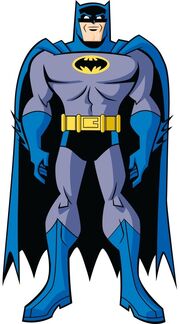
In the current animated series, Batman: The Brave and the Bold, Batman wears a slightly modified version of the blue and gray suit worn during the Silver Age stories and the 60's live action show. According to the show's creators, this was deliberately done to invoke a less dark and violent depiction of Batman following the release of The Dark Knight.
Though similar in appearance to the older costumes, this Batsuit is unique in and that it possesses a much larger amount of gadgetry than any other costume shown to date. Thus far, the Batsuit has been shown to not only contain multiple batarangs and other standard Bat-paraphernalia, but also a collapsable sword, wings, deep space gear, scuba equipment, and multiple rocket thrusters. Also, the emblem on Batman's chest can now transform into an emergency Batarang, becoming hard and riggid after being exposed to some sort of magnetic field emitted by the suit.
Batman (1989)/Batman Returns
Main: Batsuit (Burton Films)
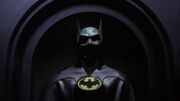
Following the camp depiction of the 1960's live-action television series, director Tim Burton's Batman films feature a black Batsuit with the yellow ellipse emblem, yellow utility belt, heavy armour placed on the chest, forearms, and boots, with the chest armour incorporating the bat-emblem. This became the basic template on which all subsequent live-action Batsuits were based.
The basic design of the suit, designed by Bob Ringwood, was based essentially on the then current Neal Adams comic book version. This suit was notable for its introduction of the grapple gun, which was later adopted by the comics, for the black eye makeup worn under the mask, which has been used in every live-action Batman film since, and for the construction of the cowl, which made it impossible for actor Michael Keaton to turn his head while wearing it.
Batman Forever/Batman & Robin
Main: Batsuit (Schumacher Films)
Batman Begins/Dark Knight
Main: Batsuit (Nolan Films)
Batman: Gotham Knight
In Batman: Gotham Knight, which is set between Batman Begins and The Dark Knight, details of the Batsuit along with Batman's attempts to improve it are shown.
The suit has many characteristics of the Batman Begins suit, but on the segment "Field Test," Batman upgrades the suit with an advanced motion scanner that has an electromagnetic gyro which produces a magnetic shield capable to deflect small-arms fire before he abandons it.
On "In Darkness Dwells," it is shown that there's an infrared scope built within the cowl, along with a rebreather that can be folded within it. There's a wireless relay communicator in the cowl. Its signals are locked with quantum cryptology and bounced through a dozen different satellites (presumably the WayneComs). As per the animation styles the suit varies between versions of the Batman Begins standard black suit and the Comic Book original.
